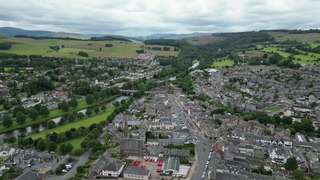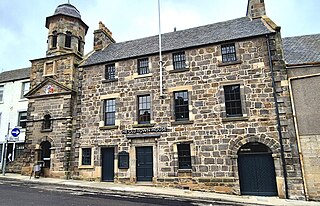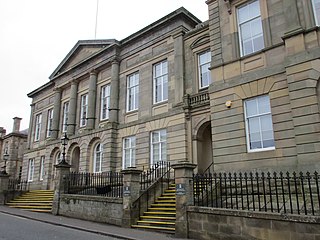
Peebles is a town in the Scottish Borders, Scotland. It was historically a royal burgh and the county town of Peeblesshire. According to the 2011 census, the population was 8,376 and the estimated population in June 2018 was 9,000.

Peeblesshire, the County of Peebles or Tweeddale is a historic county of Scotland. Its county town is Peebles, and it borders Midlothian to the north, Selkirkshire to the east, Dumfriesshire to the south, and Lanarkshire to the west.

Tweeddale is a committee area and lieutenancy area in the Scottish Borders council area in south-eastern Scotland. It had also been a province in the Middle Ages. From 1975 to 1996 it was a local government district. Its boundaries correspond to the historic county of Peeblesshire.

William Chambers of Glenormiston was a Scottish publisher and politician, the brother of Robert Chambers. The brothers were influential in the mid-19th century, in both scientific and political circles.

Galashiels Burgh Chambers is a municipal building in Albert Place, Galashiels, Scotland. The building, which was the headquarters of Galashiels Burgh Council, is a Category B listed building.

Kirkcudbright Town Hall, currently operating as Kirkcudbright Galleries, is a municipal building in St Mary's Street, Kirkcudbright, Scotland. The building, which was the headquarters of Kirkcudbright Burgh Council, is a Category B listed building.

The Dunbar Town House, also known as Dunbar Tolbooth, is a municipal structure in the High Street in Dunbar, East Lothian, Scotland. The building, which currently operates as a museum, is a Category A listed building.

County Buildings is a municipal structure in St Catherine Street in Cupar, Fife, Scotland. The building, which was the meeting place of Fife County Council, is a Category B listed building.

County Hall is a municipal structure in Rosetta Road in Peebles, Scotland. The building, which was the meeting place of Peeblesshire County Council, is a Category B listed building.

Langholm Town Hall is a municipal building in the High Street in Langholm, Dumfries and Galloway, Scotland. The structure, which is used as a community events venue, is a Category B listed building.

Sanquhar Tolbooth is a municipal building in the High Street in Sanquhar, Dumfries and Galloway, Scotland. The structure, which accommodates a local history museum, is a Category A listed building.

Anstruther Town Hall is a municipal building in School Green, Anstruther Easter, Fife, Scotland. The structure, which is used as a community events venue, is a Category B listed building.

Falkland Town Hall is a municipal building in the High Street, Falkland, Fife, Scotland. The structure, which has been converted for use as offices and as shops, is a Category A listed building.

Inverkeithing Town House is a municipal building in the Townhall Street, Inverkeithing, Fife, Scotland. The structure, which is used as a base by members of the local community council, is a Category A listed building.

Burntisland Burgh Chambers is a municipal structure in the High Street, Burntisland, Fife, Scotland. The building, which is the meeting place of the Burntisland Community Council, is a Category B listed building.

Invergordon Town Hall is a municipal building in the High Street in Invergordon in the Highland area of Scotland. The structure, which is used as a community events venue, is a Category B listed building.

Crieff Town Hall is a municipal building in the High Street, Crieff, Perth and Kinross, Scotland. The structure, which is currently used as a tourist information centre and museum, is a Category B listed building.

Coldstream Town Hall is a municipal building in the High Street, Coldstream, Scottish Borders, Scotland. The structure, which currently accommodates a library and a registration office, is a Category B listed building.

County Buildings is a municipal structure in Court Street, Haddington, East Lothian, Scotland. The structure, which was the headquarters of East Lothian County Council and was also used as a courthouse, is a Category B listed building.

Lanark Sheriff Court is a judicial building in Hope Street, Lanark, South Lanarkshire, Scotland. The building, which continues to serve as the local courthouse, is a Category B listed building.





















